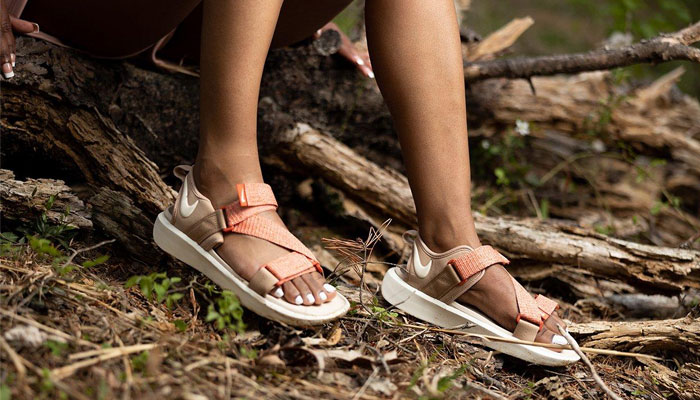
A sandal is a type of shoe that leaves most or all of the foot exposed. They are often made from natural materials such as leather, wood, or woven plant fibers. Sandals can be flat or heeled.
Many sandals feature a contoured footbed that molds to the wearer’s feet and adjustable straps for a custom fit. They may also have a non-slip sole for increased safety on different types of terrains.
Increased Risk of Athlete’s Foot
Sandals are a great choice for hot weather as they allow your feet to breathe. This breathability can help to keep your feet cool and dry, which may mitigate the development of an athlete’s foot. In contrast, shoes made from plastic or synthetic materials can cause your feet to overheat and sweat excessively, which can speed up the development of an athlete’s foot. Additionally, sandals are more likely to expose your feet to bacteria found in public environments such as showers and locker rooms, which can lead to infection.
Fungal infections such as athlete’s foot can lead to itchiness, blisters, cracking of the skin on your feet, and foul-smelling odors. The condition can be spread to others through contact with infected skin, so taking preventative measures is essential to avoid getting it. These include keeping your feet clean and dry by washing them twice a day, keeping them dry with shoes and socks that wick moisture, and applying antifungal talcum powder.
Athlete’s foot is caused by a group of fungi called Trichophyton dermatophyte that exist on your body normally, but under certain conditions can reproduce and lead to an infection. These conditions include excessive heat, sweating, irritated skin, and tight shoes that squeeze the toes together.
Athletes’ feet can be prevented by wearing sandals that allow for good airflow, and shoes made from natural materials such as leather or canvas. Also, avoiding sharing footwear or towels with other people and taking preventative measures in public areas like locker rooms, swimming pools, and saunas can reduce your risk of infection. In addition, if you do develop an athlete’s foot infection, using low-dose hydrocortisone medications purchased OTC or with a prescription from your doctor may help.
Increased Risk of Achilles Tendinitis
While sandals are usually regarded as fashionable and comfortable, they have some negative effects on the foot health of wearers. In particular, they can increase the risk of developing Achilles tendonitis.
The Achilles tendon is a strong, fibrous band of tissue that extends from the heel bone to the calf muscles. This tendon supports the weight of the body when walking, running, and jumping. Achilles tendonitis is a painful condition that occurs when the tendon becomes inflamed. It can be diagnosed using an examination x-rays, or ultrasound imaging. In most cases, nonsurgical treatment is effective for relieving pain and preventing complications.
Sandals are open-toed shoes that leave the soles and ankles of the feet exposed. They may have a flat sole or a heel, and they are typically held to the wearer’s foot by straps that go over the instep and around the ankle. Sandals may also have a peep toe or other feature that exposes the top of the foot. Sandals are worn for a variety of reasons, including comfort in warm weather, practicality (sandals require less material than closed shoes), and as a fashion accessory.
Looking stylish and fashionable doesn’t have to break the bank. With the Shoes Discount, you can save money on outfits and accessories. Shoes Discount offers a wide variety of clothing items, from casual wear to formal attire, all at affordable prices. You can also find the perfect accessories to complete your look, such as jewelry, hats, and handbags. Don’t sacrifice style for cost, check out Shoes Discounts today and look your best without breaking the bank!
When choosing a pair of sandals, make sure that they fit the feet comfortably and that they provide adequate support. Many sandals are made of low-quality materials that can cause bunions, calluses, blisters, and other uncomfortable conditions. It’s also important to choose a pair of sandals that prioritize cushioning and arch support. This will help to reduce the amount of stress placed on the feet while walking and will prevent foot fatigue and soreness.
Increased Risk of Plantar Fasciitis
Plantar fasciitis, an inflammation of the long bands of tissue that support the bottom of your foot, is another foot injury that can be aggravated by certain types of sandals. The condition affects the heel and arch of the foot, and it can cause achy pain in the heel or bottom of your foot that gets worse when you stand or walk. It can also feel worse after sitting or standing for a long time.
Experts recommend avoiding flat, non-supportive shoes or sandals if you have plantar fasciitis. They include flip flops, and footwear that doesn’t have the proper foot support such as Converse or Vans unless they give you a heel cup or insole and outsoles. Instead, look for a sandal with a small heel to minimize stretching on the fascia, one that fits your feet well with an adjustable strap, and that has firm cushioning to prevent slipping or excessive pressure on the foot.
To avoid further irritating your plantar fasciitis and to help relieve existing symptoms, experts recommend wearing supportive footwear all the time, even during summertime when you’re mostly on your feet. When shopping for sandals, look for ones that offer ample cushioning, support, and stability, like the UTENAG’s Comfort Sandals with a high-arch footbed that supports your arch, and straps that are snug without being too tight on your ankle.
The best sandals for plantar fasciitis should be comfortable right away, Dr. Sharkey says. Sandals that require breaking in can cause rubbing and discomfort, which can prolong your plantar fasciitis symptoms. Look for lightweight sandals, with a soft and breathable fabric, and that doesn’t rub or chafe on your feet. You’ll also want sandals with plenty of shock absorption, as this can help redistribute the weight and pressure on your feet and alleviate the stress on the plantar fascia.
If you’re looking for some stylish and comfortable outfits for women that won’t break the bank, look no further than Merrell Ca Coupons! With discounts on a variety of shoes and clothing, you can put together a fashionable and practical outfit for any occasion. Pair a cute sundress with some comfortable sandals for a day out, or opt for some athletic wear for a workout. With Merrell Ca Coupons, you can look good and feel good without spending a fortune.
Increased Risk of Bunions
Bunions develop when the first metatarsal bone of your foot (the one at the base of your big toe) deforms. It becomes longer and wider than it should be, pushing your toes into an unnatural position that causes your big toe to point toward your smaller toes. Over time, the pressure from your shoes (along with other factors such as heredity and the shape of your feet) causes a painful bump to form on the outside of your big toe joint. Bunions are often accompanied by pain and swelling in the ball of your foot and may even cause arthritis.
Although there’s some evidence that tight, narrow shoes are a risk factor for bunion development, experts don’t know if this is because they cause the bunions or because the shoes exacerbate underlying issues that are more likely to lead to bunions. For example, bunions are more common in people who have a family history of them or in those with certain foot structure problems such as flat feet, and they’re also linked to inflammatory conditions like rheumatoid arthritis.
Shine’s study of the island residents found that while some people who never wear shoes get bunions, many people who regularly wear tight, narrow footwear have them. The incidence of bunions rose linearly with the number of years the participants had worn shoes.
While wearing sandals puts your feet at greater risk for developing bunions, there are a few things you can do to lower your risk of the condition and reduce the symptoms you experience if you already have them. Wear shoes with a wide toe box and avoid pointed or high-heeled shoes. If you must wear shoes with a high heel, opt for ones that have a low pitch to reduce the amount of pressure on your front toes.
Increased Risk of Stress Fractures
People with weak bones are at a higher risk of stress fractures, especially in the feet and legs. Stress fractures are small cracks within a bone that develops when there is too much pressure on a bone over a long period. This pressure may come from an overuse injury (like running too often or doing the same type of workout too many times) or a sudden increase in physical activity.
Sandals have been worn since prehistoric times, with some of the oldest sandals being made from sagebrush bark in what is now the U.S. state of Oregon. The ancient Greeks and Romans also wore sandals, with high-ranking officials wearing sandals made of gold or papyrus, and regular citizens wearing sandals of leather, wood, and other natural materials. In more modern times, sandals have been made from a variety of materials including woven plant fibers such as sea grass or jute, molded plastics, and leather, as well as fur and animal hides.
Sandals are most commonly worn in warmer climates and during summer months. They are available in a wide range of heel heights, from flat to stiletto, and in an array of colors and styles. They are typically made from a more durable material than flip flops, with most being designed with closed backs and strappy uppers. Flip flops, on the other hand, are made with less sturdy materials such as rubber and rope. The popularity of sandals increased during World War II because they use less leather than enclosed shoes and can be made from rationed materials such as twisted or woven fibers. The popularity of sandals has continued to rise because they are comfortable and versatile, but a foot doctor should be consulted before they are used for a prolonged time.
Conclusion
Plantar fasciitis, an inflammation of the long bands of tissue that support the bottom of your foot, is another foot injury that can be aggravated by certain types of sandals. While wearing sandals puts your feet at greater risk for developing bunions, there are a few things you can do to lower your risk of the condition and reduce the symptoms you experience if you already have them. The ancient Greeks and Romans also wore sandals, with high-ranking officials wearing sandals made of gold or papyrus, and regular citizens wearing sandals of leather, wood, and other natural materials.








